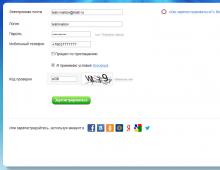Mozilla firefox как найти все пароли. Сохраненные пароли в Mozilla Firefox
«Фаерфокс» – настоящий мультитул от мира браузеров, аналогов которому не найти. Он подходит как обычным продвинутым пользователям, так и веб-девелоперам/верстальщикам , для которых работа с сайтами – это полноценная профессия. Соответственно, разработчики стараются сделать использование браузера максимально комфортным для всех. В том числе со стандартной возможностью сохранять пароли прямо в браузере.
Но где хранятся пароли в Firefox и стоит ли переживать об их защите?
Сохраняет «Мозилла» все пароли в виде так называемых куки-файлов, где данные хранятся в зашифрованном виде. Но всё же хранятся они не в облачном хранилище , под тысячью замков, а у вас на жестком диске . Соответственно, браузер хранит в зашифрованному виде всю полученную от пользователя информацию, и чтобы её заполучить, достаточно получить доступ к файловой системе ПК.
Где хранятся пароли в Firefox, знает большая часть хакеров и продвинутых пользователей. Все данные сохраняются не в Мозиле Фаерфокс, а в соответствующей папке на диске C вашего ПК.
И стоило бы переживать о безопасности данных и о том, что их сохраняют не напрямую в браузере, если не несколько нюансов:
- расшифровать сохраненную информацию можно лишь в том случае, если у вас есть ключ, который хранится в условном «аккаунте» браузера. Соответственно, пользователь может свободно переносить свои данные, а злоумышленник, даже заполучив злополучные файлы, не сможет с ними ничего сделать;
- «Фаерфокс» хранит далеко не каждый введённый вами пароль, и прежде чем что-то записать в базу данных, – он спрашивает разрешения. Соответственно, в любой момент, самые важные данные, вы можете защитить. А уже сохраненные куки можно просто стереть через настройки браузера, если это потребуется.
Вот мы и разобрались, как браузер хранит всю собранную информацию, но как посмотреть сохраненные пароли в Mozilla Firefox и возможно ли это сделать, или же у вас есть лишь инструмент для автоматической авторизации в различных сервисах
Просмотр сохраненной информации
Чтобы просмотреть, какой пароль привязан к конкретному логину на сайте, нужно:

Если вас всё же беспокоит безопасность, и вы не хотите хранить в куки конфиденциальную информацию, а предложения браузера сохранить пароли – уже надоели, то можете просто запретить «Мозилле» делать подобное. Для этого, зайдите в тот же пункт меню и уберите галочку с пункта «Запрашивать сохранение логинов и паролей для веб-сайтов».
Если вы не хотите каждый раз вводить пароль, когда заходите на какой-нибудь сайт, например, в любимую социальную сеть, вы можете сохранить пароль в браузере Mozilla Firefox, благо, сделать это очень просто.
Сразу хотелось бы сделать небольшое отступление. Я настоятельно не рекомендую сохранять пароли в браузере по той простой причине, что оттуда их может «увести» троян. И хорошо, если речь идет о пароле от социальной сети, но если это пароль от какого-нибудь интернет-кошелька, деньги с него могут перевести на другой счет. В общем, я свое мнение выразил, а стоит ли ему следовать, решать только вам.
Теперь о сохранении паролей. По умолчанию спрашивает вас о сохранении любого введенного пароля. Если этого не происходит, то необходимо включить сохранение паролей в настройках.
В меню нажмите на пункт «Инструменты», затем выберите «Настройки».

Откроется окно с настройками. В нем нужно выбрать пункт «Защита». Поставьте галочку рядом со словами «Запоминать пароли для сайтов».


Для того, что бы отключить функцию запоминания паролей, вам необходимо будет снять галочку с пункта «Запоминать пароли для сайтов» в настройках.
Помните, что некоторые сайты не позволяют запоминать пароли. Сюда относятся, к примеру, сайты платежных систем. Это сделано для безопасности пользователей.
The Firefox Password Manager securely stores the usernames and passwords you use to access websites and then automatically fills them in for you the next time you visit a website. This article will show you how to use the Password Manager to remember, view, delete and protect your passwords.
Table of Contents
Make Firefox remember usernames and passwords
When you enter a username and password that you haven"t already saved for a website, Firefox will ask if you want to remember save it.
Tip: Clicking outside of the Remember Save prompt will hide it. To bring it back, just click the key icon on the left side of the address bar. If Firefox does not prompt you to save passwords, see the article Usernames and passwords are not saved .
- To have Firefox remember your username and password
, click on Remember
Save
. The next time you visit the website, Firefox will automatically enter your username and password for you.
- If you"ve stored the wrong username or password, just type the right one into the website and Firefox will prompt you to save it. To save the new username and password, click on Update .
- To tell Firefox to never remember usernames and passwords for the current website
, click the drop-down menu and select Never Remember Password for This Site
Never Save
. In the future, when you log in to the website you won"t be prompted to save the username and password.
- If you later change your mind and would like Firefox to ask you to save usernames and passwords for this site, you"ll need to go into your Firefox Options and remove the site"s entry from the Security panel Privacy & Security panel exceptions list. If you later change your mind and would like Firefox to ask you to save usernames and passwords for this site, you"ll need to go into your Firefox Preferences and remove the site"s entry from the Security panel Privacy & Security panel exceptions list.
- To skip saving your username and password this time , click the drop-down menu and select Not Now click Don"t Save . You"ll be prompted to save your username and password the next time you visit the site.
Note: Some websites offer to keep you logged in by clicking a check box on the site. This is a feature of the website and will work whether or not you have saved your username and password in Firefox.
Managing multiple accounts for a site
If you have more than one account for a site, Firefox can save all your logins. You can make Firefox fill in login information for a different account each time you visit.
If more than one login is stored for a website, the list of usernames will appear when you click into the login field. Just select the username you want to log in with.
Viewing and deleting passwords
To view passwords for a specific site , right-click control +click on the username field on that site, then click Fill Login , followed by View Saved Logins , as shown above.
You can easily manage the usernames and passwords that Firefox has saved for you.
- To see the passwords you have saved , click Show Passwords . When you close the window, your passwords will be automatically hidden.
- Use the search box to find a particular website or username. Click the X in the search bar to clear your search and see the full list again.
- To remove the username and password for a website , select the site"s entry from the list and click Remove .
- To remove all stored usernames and passwords , click Remove All . After confirming this choice, all of your stored usernames and passwords will be deleted.
- To import passwords from Chrome or Internet Explorer , click Import… and follow the instructions in the wizard.
Note: The Password Manager Import feature is currently available on Windows only.
Protecting your passwords
If you use the same simple password for everything you will be more susceptible to identity theft . The Create secure passwords to keep your identity safe article shows you an easy method for creating secure passwords and using the Password Manager, as described above, will help you remember them all.
All of the changes you make in Firefox, like your home page, what toolbars you use, extensions you have installed, saved passwords and your bookmarks, are all stored in a special folder, called a profile . Your profile folder is stored in a separate place from the Firefox program so that, if something ever goes wrong with Firefox, your information will still be there. It also means you can uninstall Firefox without losing your settings and you don"t have to reinstall Firefox to clear your information or troubleshoot a problem.
Table of Contents
How do I find my profile?
Click the menu button , click Help and select Troubleshooting Information . From the Help menu, choose Troubleshooting Information . The Troubleshooting Information tab will open.
- Under the Application Basics section, click on Open Folder Show in Finder Open Directory . A window will open that contains your profile folder. Your profile folder will open.
Finding your profile without opening Firefox
Firefox stores your profile folder in this location on your computer, by default:
C:\Users\
Windows hides the AppData
folder by default but you can find your profile folder as follows:
- From the Start Screen, click the Desktop tile. The Desktop view will open.
- From the Desktop, hover in the lower right-hand corner to access the Charms.
- Select the Search charm. The Search sidebar will open.
- In the search box, type in:
%APPDATA%\Mozilla\Firefox\Profiles\
without pressing Enter. A list of profile folders will appear. - Click on the profile folder you wish to open (it will open in a window). If you only have one profile, its folder would have "default" in the name.
- Click the Finder icon in the dock. On the menu bar, click the Go menu, hold down the option or alt key and select Library . A window will open containing your Library folder.
- Open the Application Support folder, then open the Firefox folder, and then the Profiles folder.
- Your profile folder is within this folder. If you only have one profile, its folder would have "default" in the name.
- (Ubuntu) Click the Places menu on the top right of the screen and select Home Folder . A File Browser window will appear.
- Click the View menu and select Show Hidden Files if it isn"t already checked.
- Double click the folder marked .mozilla .
- Double click the folder marked firefox . Your profile folder is within this folder. If you only have one profile, its folder would have "default" in the name.
What information is stored in my profile?
Note: This is not a complete list. Only important information is described.
- Bookmarks, Downloads and Browsing History: The places.sqlite file contains all your Firefox bookmarks and lists of all the files you"ve downloaded and websites you’ve visited. The bookmarkbackups folder stores bookmark backup files, which can be used to restore your bookmarks. The favicons.sqlite file contains all of the favicons for your Firefox bookmarks. For more information, see Bookmarks in Firefox and Restore bookmarks from backup or move them to another computer .
- Passwords: Your passwords are stored in the key4.db and logins.json files. For more information, see Password Manager - Remember, delete, change and import saved passwords in Firefox .
- Site-specific preferences: The permissions.sqlite and content-prefs.sqlite files store many of your Firefox permissions (for instance, which sites are allowed to display popups) or zoom levels that are set on a site-by-site basis (see Font size and zoom - increase the size of web pages).
- Search engines: The search.json.mozlz4 file stores user-installed search engines. For more information, see Add or remove a search engine in Firefox .
- Personal dictionary: The persdict.dat file stores any custom words you have added to Firefox"s dictionary. For more information, see How do I use the Firefox spell checker? .
- Autocomplete history: The formhistory.sqlite file remembers what you have searched for in the Firefox search bar and what information you’ve entered into forms on websites. For more information, see Control whether Firefox automatically fills in forms .
- Cookies: A cookie is a bit of information stored on your computer by a website you’ve visited. Usually this is something like your site preferences or login status. Cookies are all stored in the cookies.sqlite file.
- DOM storage: DOM Storage is designed to provide a larger, more secure, and easier-to-use alternative to storing information in cookies. Information is stored in the webappsstore.sqlite file for websites and in the chromeappsstore.sqlite for about:* pages.
- Extensions: The extensions folder, if it exists, stores files for any extensions you have installed. To learn more about Firefox extensions and other add-ons, see Find and install add-ons to add features to Firefox .
- Security certificate settings: The cert9.db file stores all your security certificate settings and any SSL certificates you have imported into Firefox.
- Security device settings: The pkcs11.txt file stores security module configuration.
- Download actions: The handlers.json file stores your preferences that tell Firefox what to do when it comes across a particular type of file. For example, these are the settings that tell Firefox to open a PDF file with Acrobat Reader when you click on it. For more information, see Change what Firefox does when you click on or download a file .
- Stored session: The sessionstore.jsonlz4 file stores the currently open tabs and windows. For more information, see Restore previous session - Configure when Firefox shows your most recent tabs and windows .
- Toolbar customization: The xulstore.json file stores toolbar and window size/position settings. For more information, see
Здравствуйте, уважаемые посетители моего блога! Сегодня мы поговорим о сохраненных паролях в браузере Mozilla Firefox. Как известно, всяких сервисов в Интернете много, в некоторых из них вы, естественно, зарегистрированы. И в каждом из этих сервисов нужно вводить логин и пароль. Я, конечно, сомневаюсь, что вы все их помните.
Практически во всех браузерах есть функция для их автоматического сохранения. Исключением не является и Мозила. Конечно, к чему бы ему отставать. Это когда-то был самый популярный браузер.
Если вы не хотите сохранять подобные данные в отдельном файле или на листочке, то одним из способов является сохранить их прямо в браузере.
Вы, наверное, знаете и замечали, что при заходе на какой-нибудь сайт, где нужно будет ввести данные для авторизации, у вас выскакивает подобное окошко, с предложением запомнить введенный набор символов. Если вы хотите их запомнить и больше не вводить, то жмите на соответствующую кнопку:
Как посмотреть сохраненные пароли в Мозиле
Жмем на кнопочку меню в правом верхнем углу и из выпавшего списка выбираем пункт «Настройки».

В открывшемся окне переходим в раздел «Защита», убеждаемся, что стоит птичка напротив пункта «Запоминать логины для сайтов». Жмем на кнопку «Сохраненные логины».

Перед нами открывается список адресов, данные для которых вы сохранили. Для того чтобы посмотреть их жмем на кнопку «Отобразить пароли».

Теперь, кроме логинов, у нас отображаются еще и соответствующие им комбинации символов. Для того чтобы удалить пароль в Мозиле, выделите необходимый сайт и нажмите на кнопку «Удалить».

Если Мозила не сохраняет пароли сайтов
Значит, подобные страницы добавлены в исключения. Для того чтобы добавить сайт в исключения (его логин и пароль больше никогда не сохранится в браузере), достаточно, просто при запросе на его запоминание нажать на стрелочку возле слова «Запомнить» и из выпавшего меню выбрать пункт «Никогда не запоминать пароль для этого сайта».

Если сайт попал в исключения, то предложение о сохранении личных данных, после авторизации, выводиться больше не будет.
Чтобы проверить, действительно ли он находится в данном списке, и удалить его оттуда, выполняем следующие действия.
Идем по уже знакомому нам пути, нажимаем на настройки и переходим в раздел «Защита», находим подраздел «Логины» и нажимаем на кнопку «Исключения».

Находим в списке искомые нами адреса. Если хотите удалить некоторые из них, то выделите и нажмите на соответствующую кнопку:




